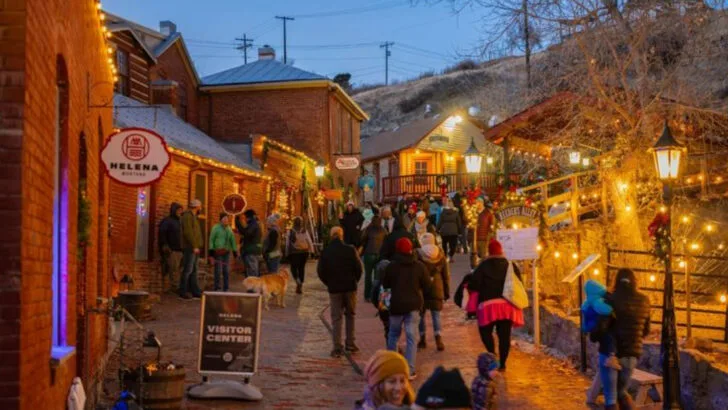Montana doesn’t whisper its history—it shouts it from ghost towns and battlefields. You can feel it in the wind as it rolls over prairie grass. You can see it in weathered saloons, rusted railways, and gold-rush streets still clinging to the past. This isn’t a state of vague memories. It’s a place where stories stand tall in timber, stone, and grit. Walk where outlaws rode. Stand where legends were made. And discover towns that haven’t let time win. These 13 places aren’t just history—they’re alive, with echoes of gunfire, train whistles, and barroom laughter still bouncing off the mountains. Forget polished museums. Montana invites you to step into the dust, breathe in the past, and leave with your boots a little dirtier and your heart a little fuller.
Virginia City – A Preserved Gold Rush Town
In Virginia City, the past whispers through wooden boardwalks and vintage saloons. Once a bustling hub for gold prospectors, this 1860s town remains remarkably preserved. Summer brings actors in period clothing, adding a theatrical touch to its storied streets.
Ride in a vintage stagecoach or watch skilled blacksmiths hammer out history by hand. Virginia City’s dedication to preserving its vibrant past makes it a living museum where stories of fortune and adventure unfold.
Experience the thrill and hardships of the Gold Rush era in this captivating setting, where every corner holds a tale to tell.
Bannack State Park – A Ghost Town Frozen in Time
Bannack State Park is where history stands still. Founded in 1862 as Montana’s first territorial capital, it’s now a mesmerizing ghost town. Wander through over 50 original buildings, from the schoolhouse to the sheriff’s office.
Unlike typical museums, Bannack allows you to explore open buildings freely, with only creaky floors and peeling paint as your guides. This raw, unfiltered experience offers an authentic glimpse into a bygone era.
Bannack’s haunting beauty and historical significance create a unique atmosphere, inviting visitors to step back in time and feel the weight of history in every timber.
Little Bighorn Battlefield – Remembering a Complex History
The Little Bighorn Battlefield stands as a poignant reminder of the 1876 clash between U.S. troops and Lakota and Cheyenne warriors. This national monument tells a complex story through gravestones, walking trails, and interpretive signs.
Personal narratives, particularly from Native perspectives, enrich the experience, offering a multifaceted view of this historic event. The site educates visitors on a layered history that transcends mere military tactics.
Reflective and solemn, Little Bighorn invites contemplation on bravery, conflict, and the enduring impact of history, ensuring the voices from both sides are heard and respected.
Grant-Kohrs Ranch – Life on a 19th Century Cattle Ranch
Grant-Kohrs Ranch transports you to the rugged world of 19th-century cattle ranching. Located near Deer Lodge, this National Historic Site showcases daily ranching life with real livestock and working demonstrations.
The original ranch house, adorned with period furniture and family heirlooms, offers a glimpse into the past. Rangers, clad in cowboy gear, share tales of branding, cattle drives, and ranch adventures.
This immersive experience paints a vivid picture of cowboy life, blending historical authenticity with lively stories, making it a must-visit for history enthusiasts and curious travelers alike.
The Conrad Mansion Museum – Kalispell
The Conrad Mansion Museum, a stunning example of Victorian elegance, was built in 1895 for Charles E. Conrad, a founder of Kalispell. This beautifully preserved mansion offers a glimpse into the opulent lifestyle of the early 20th century. From its grand hallways to meticulously maintained gardens, it feels as though one has stepped back in time.
Visitors can explore the mansion’s original furnishings, giving insight into the Conrad family’s daily life. Each room tells a story, from intimate family gatherings to lavish social events. The mansion not only reflects the wealth of its original owners but also a pivotal era in Montana’s history.
Guided tours provide a rich narrative, weaving the Conrads’ personal history with the broader context of Kalispell’s development. This immersive experience makes the museum a must-visit for history enthusiasts.
Butte – Mining Riches and Labor History
Butte’s skyline is punctuated by towering mining headframes, symbols of its copper-rich past. Once a melting pot of immigrants, this city preserves a unique history of industry and labor.
Stroll through neighborhoods filled with grand mansions and modest workers’ homes, each with stories etched in brick and stone. The imposing Berkeley Pit serves as an eerie reminder of industrial might.
Butte’s mix of opulence and grit reflects a fascinating chapter of American history, inviting visitors to explore its streets and uncover the tales of miners, entrepreneurs, and dreamers.
Helena – Capitol City With Gold Rush Roots
Helena, Montana’s capital, began as a gold camp known as “Last Chance Gulch,” and its historic district still carries the name. The city boasts ornate 19th-century architecture, from the state capitol to Victorian mansions.
Visitors can pan for gold in nearby streams, reliving the thrill of the Gold Rush. Guided trolley tours offer a glimpse into Helena’s opulent past, where fortunes were made and lost.
Helena’s blend of political significance and gold rush excitement creates an engaging narrative, where history is etched into every building and street corner.
Great Falls – Lewis & Clark and Frontier Exploration
Great Falls was pivotal for the Lewis and Clark expedition, who navigated its challenging waterfalls. The Lewis and Clark Interpretive Center provides insights into their journey, complete with life-size dioramas.
Visitors can explore hands-on exhibits that bring their expedition to life, highlighting interactions with Native tribes and the trials faced during their quest for discovery.
Great Falls is a tribute to exploration and resilience, where history is not just taught but felt, turning textbook tales into a vivid adventure that resonates with all ages.
Big Hole National Battlefield – A Quiet, Powerful Site
Big Hole National Battlefield honors the Nez Perce who fought and fell here during their 1877 flight toward Canada. This solemn site offers walking trails through a landscape that echoes with history.
Interpretive signs and quiet paths invite reflection on this poignant chapter of American history, where courage and tragedy intertwined.
Visitors often describe the silence of Big Hole as a powerful aspect of the experience, adding an emotional depth that words alone cannot convey.
Philipsburg – A Mining Town Turned Time Capsule
Philipsburg enchants with its colorful historic buildings and small-town charm. Once a silver mining hub, it now invites visitors to experience its rich heritage and fun activities.
From sapphire digging to exploring antique shops, there’s a treasure trove of experiences awaiting. The Opera House still hosts performances, adding a cultural twist to this quaint town.
Philipsburg’s vibrant past and lively present create a delightful blend of history and entertainment, making it a charming destination for all who venture here.
Museum of the Plains Indian (Browning)
Located on the Blackfeet Reservation, the Museum of the Plains Indian offers a rich tapestry of Native culture. From clothing to beadwork, the exhibits celebrate the vibrant traditions of multiple Plains tribes.
Unlike typical museums, this one focuses on Native history told from Native perspectives, providing an authentic and respectful narrative.
Visitors are invited to experience living cultures that continue to thrive, making the museum a place of learning, respect, and cultural appreciation.
Museum of the Rockies (Bozeman) – More Than Dinosaurs
Though famed for its dinosaur collection, the Museum of the Rockies in Bozeman offers much more. Exhibits on early settlers and Native peoples provide a nuanced view of history.
Outside, a recreated homestead with costumed interpreters brings the frontier era to life. Witnessing a working blacksmith forge adds a tangible connection to the past.
This museum’s diverse exhibits offer a rich experience, blending paleontology with history and culture, making it a must-see for visitors of all ages.
C.M. Russell Museum (Great Falls) – The Artist of the West
Dedicated to cowboy-artist Charles M. Russell, this museum in Great Falls celebrates the art and life of a Western legend. His paintings and sketches capture the spirit of Montana ranch life and Native traditions.
Visitors can explore his log cabin studio, filled with personal artifacts like paintbrushes and saddles. This intimate setting offers a glimpse into the creative world of Russell.
The C.M. Russell Museum is a testament to the power of art to preserve history and culture, providing a visual journey through the early 1900s American West.

